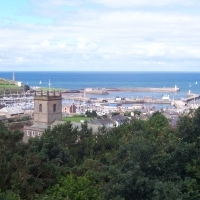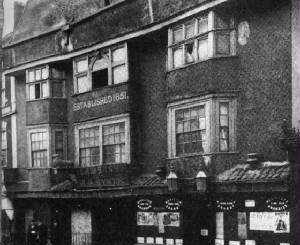The Bedford Public House, Balham
The Bedford public house at 77 Bedford Hill dates back the 1830’s when it was originally opened as a hotel. Long known as a popular live music venue, it has even hosted early gigs by bands including U2 and The Clash. However, the story relating to its reputed haunting dates back to 1876, when The Bedford was used as a venue for the Inquest into the death of Charles Bravo, a case that became a Victorian media murder sensation.
 Charles Bravo (formerly Charles Delauney Turner) (born 1845 – died 21 April 1876) was a barrister living at The Priory, Bedford Hill, Balham. On the evening of 18 April 1876 he was found unconscious at this home after taking a fatal dose of the poison potassium antimony. He did eventually regain full consciousness and though in great pain, survived a further 54 hours, during which time he did not shed any light on how he was poisoned. Charles Bravo eventually died on 21 April 1876.
Charles Bravo (formerly Charles Delauney Turner) (born 1845 – died 21 April 1876) was a barrister living at The Priory, Bedford Hill, Balham. On the evening of 18 April 1876 he was found unconscious at this home after taking a fatal dose of the poison potassium antimony. He did eventually regain full consciousness and though in great pain, survived a further 54 hours, during which time he did not shed any light on how he was poisoned. Charles Bravo eventually died on 21 April 1876.
The first inquest was held at the Priory on 25 April 1876. Rather than returning the expected verdict of suicide, the inquest jury returned an open verdict and a trial by inquest followed in the Billiard Hall (now the Ballroom) of The Bedford Hotel (The Bedford), starting on 11 July 1876. A verdict of Wilful Murder we recorded on 11 August 1876, though there was not enough evidence to discern who the guilty party was. “We find that Charles Delaunay Turner Bravo did not commit suicide; that he did not meet his death by misadventure; that he was wilfully murdered by the administration of tarter emetic; but there is not sufficient evidence to fix the guilt upon any person or persons.”
The three key individuals of interest were, Florence Bravo (wife of the deceased), Dr James Manby Gully (the ex lover of Mrs Bravo) and Mrs Jane Cannon Cox (the housekeeper/maid/companion).
 The wealthy Florence Ricardo (née Campbell) married Charles Bravo on 7 December 1875, just over four months before the poisoning occurred. Her first husband had been Alexander Louis Ricardo (or Algernon Lewis Ricardo) (born 1843– died 1871) a Captain in the Grenedier Guards (dishonorably discharged) and the son of the Member of Parliament for Stoke on Trent, John Lewis Ricardo (born 1812 – died 2 August 1862). The marriage was an unhappy one and Ricardo is referred to as having been a violent alcoholic who had a string of affairs, so Florence eventually left him. Following the death of Ricardo she was free to marry again, but Charles Bravo proved to be a mean, bullying, controlling husband who resented his richer wife for opting to retain control of her own superior finances.
The wealthy Florence Ricardo (née Campbell) married Charles Bravo on 7 December 1875, just over four months before the poisoning occurred. Her first husband had been Alexander Louis Ricardo (or Algernon Lewis Ricardo) (born 1843– died 1871) a Captain in the Grenedier Guards (dishonorably discharged) and the son of the Member of Parliament for Stoke on Trent, John Lewis Ricardo (born 1812 – died 2 August 1862). The marriage was an unhappy one and Ricardo is referred to as having been a violent alcoholic who had a string of affairs, so Florence eventually left him. Following the death of Ricardo she was free to marry again, but Charles Bravo proved to be a mean, bullying, controlling husband who resented his richer wife for opting to retain control of her own superior finances.
In 1872, Florence had had an affair with the much older and married Dr James Manby Gully (born 14 March 1808 – died 1883), a well known Victorian physician renowned for his hydrotherapies. Florence fell pregnant in 1873 whilst they were visiting Kissingen in Germany and Dr Gully performed an abortion and the complications with it nearly killed her. Though this effectively ended there sexual relations, they remained friends and Gully was reportedly very angry when he heard that Florence had married Charles Bravo, but according to his Butler, had given his blessings to the union. Through his involvement with Florence, Dr Gully was regarded as a suspect and attended the inquest to testify. He is however regarded as a very unlikely suspect and not thought to be implicated in the death of Charles Bravo.
The third person of interest was the maid, Mrs Jane Cannon Cox. She was a widow with three children and in a bid to save money Charles Bravo had instructed Florence to sack her. On the night of the poisoning she was apparently evasive. She also told the police a lie, probably to deflect attention from herself and Mrs Bravo, saying that Mr Bravo had mentioned committing suicide and taking the poison.
 No one was ever brought to justice for the murder of Charles Bravo, but there are a few theories that surround his death. Charles Bravo may have actually committed suicide. It has been suggested that he was actually poisoning Mrs Bravo to gain control of her money but accidently killed himself. He may have been poisoned by Mrs Cox in fear of losing her job, but in her defence it has been pointed out that she stood to inherit, or owned, three plantations in the West Indies, so she had money available and needn’t have killed him for fear of being put onto the streets. Another theory is that Mrs Bravo was frightened of falling pregnant again after two miscarriages (one in January 1876 and another just before the murder in April 1876) and that she used the poison to make Charles ill and avoid sleeping with him. This was a genuine fear and Charles Bravo insisted on of Florence giving him a child. He would also exert his control over her by making her perform degrading sexual acts. It is suggested that she may have had experience with antimony as it was sometimes used by Victorian women to control alochol addiction in their husbands and Florence had previously been married to a violent alcoholic.
No one was ever brought to justice for the murder of Charles Bravo, but there are a few theories that surround his death. Charles Bravo may have actually committed suicide. It has been suggested that he was actually poisoning Mrs Bravo to gain control of her money but accidently killed himself. He may have been poisoned by Mrs Cox in fear of losing her job, but in her defence it has been pointed out that she stood to inherit, or owned, three plantations in the West Indies, so she had money available and needn’t have killed him for fear of being put onto the streets. Another theory is that Mrs Bravo was frightened of falling pregnant again after two miscarriages (one in January 1876 and another just before the murder in April 1876) and that she used the poison to make Charles ill and avoid sleeping with him. This was a genuine fear and Charles Bravo insisted on of Florence giving him a child. He would also exert his control over her by making her perform degrading sexual acts. It is suggested that she may have had experience with antimony as it was sometimes used by Victorian women to control alochol addiction in their husbands and Florence had previously been married to a violent alcoholic.
The truth may never be known. Florence Bravo moved to Southsea, publicly disgraced and disowned. She died of alcohol poisoning two years later at the gae of 33 years. Cox went to her plantations in Jamaica and and returned to England to die in 1913.
Haunting?
There are a few websites now claiming that The Bedford is haunted by, well the most unlikely of the suspects, Dr Gully, who was actually nowhere near the murder scene. I’m not sure of the pimary source for the suggestion that the pub is haunted or what sort experiences are said to have occurred there or whether it is just a story to tie in with this interesting piece of history.




Recent Comments